Speech Disorders Exam 2
1/89
There's no tags or description
Looks like no tags are added yet.
Name | Mastery | Learn | Test | Matching | Spaced |
|---|
No study sessions yet.
90 Terms
Articulation
creation of speech sounds using movements of the vocal tract
Vowels
produced with more OPEN vocal tract and are ALWAYS VOICED
Consonants
produced with a more CONSTRICTED vocal tract and can be voiced or unvoiced
what is the source-filter theory?
states that a voicing source is generated by the vocal folds and is routed through the vocal tract
the voice is shaped or filtered into the sounds of speech by movement of the vocal tract
What is the source?
voice
What is the filter?
the way you shape your mouth and vocal tract
What is resonance?
the frequency regions of high acoustic energy
happens because of our filter (vocal tract) shape
What are the cavities of the vocal tract?
pharynx
a. laryngopharynx
b. oropharynx
c. nasopharynx
velopharyngeal port
nasal cavity
oral cavity
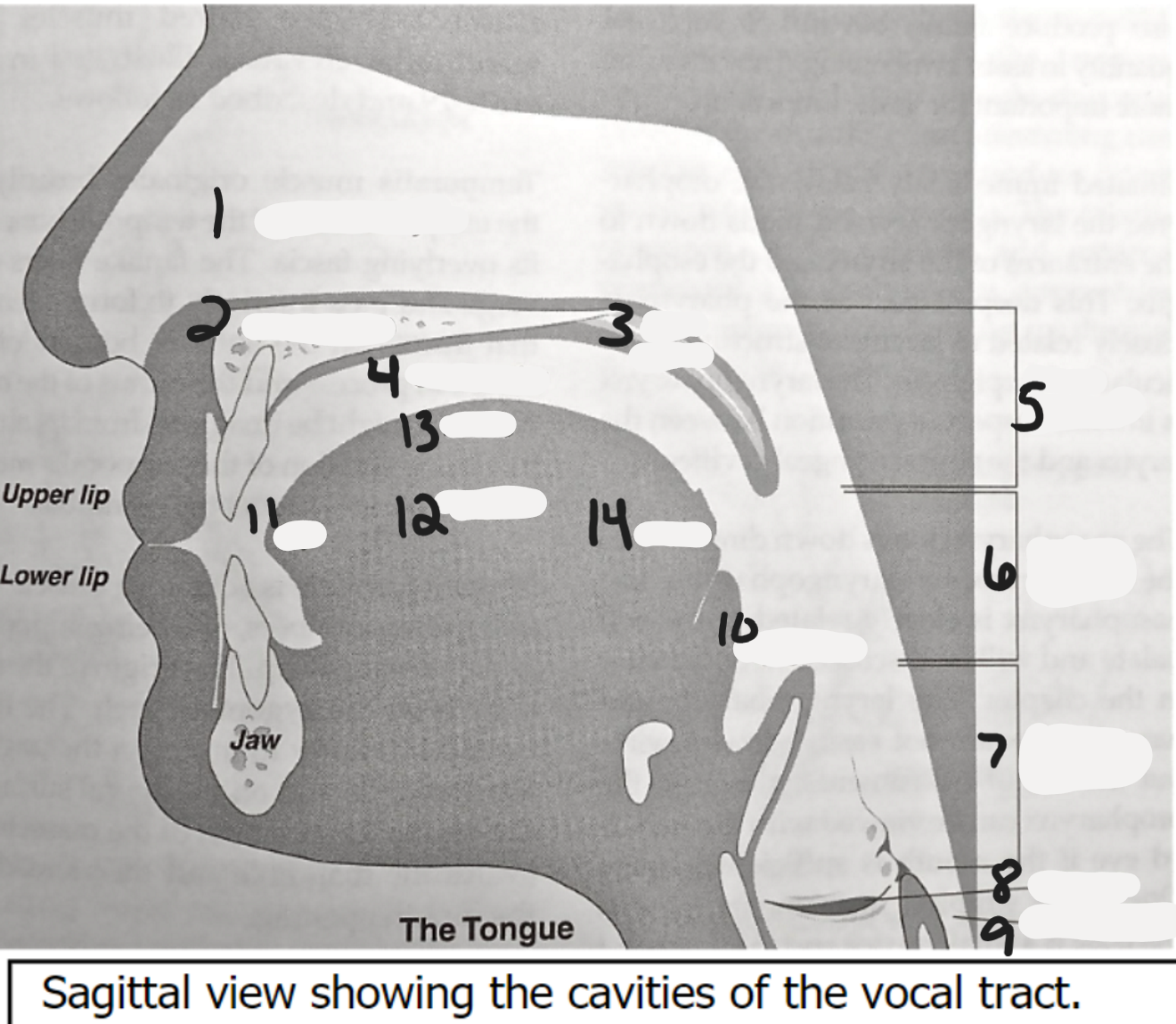
What is #1 on the diagram?
Nasal Cavity
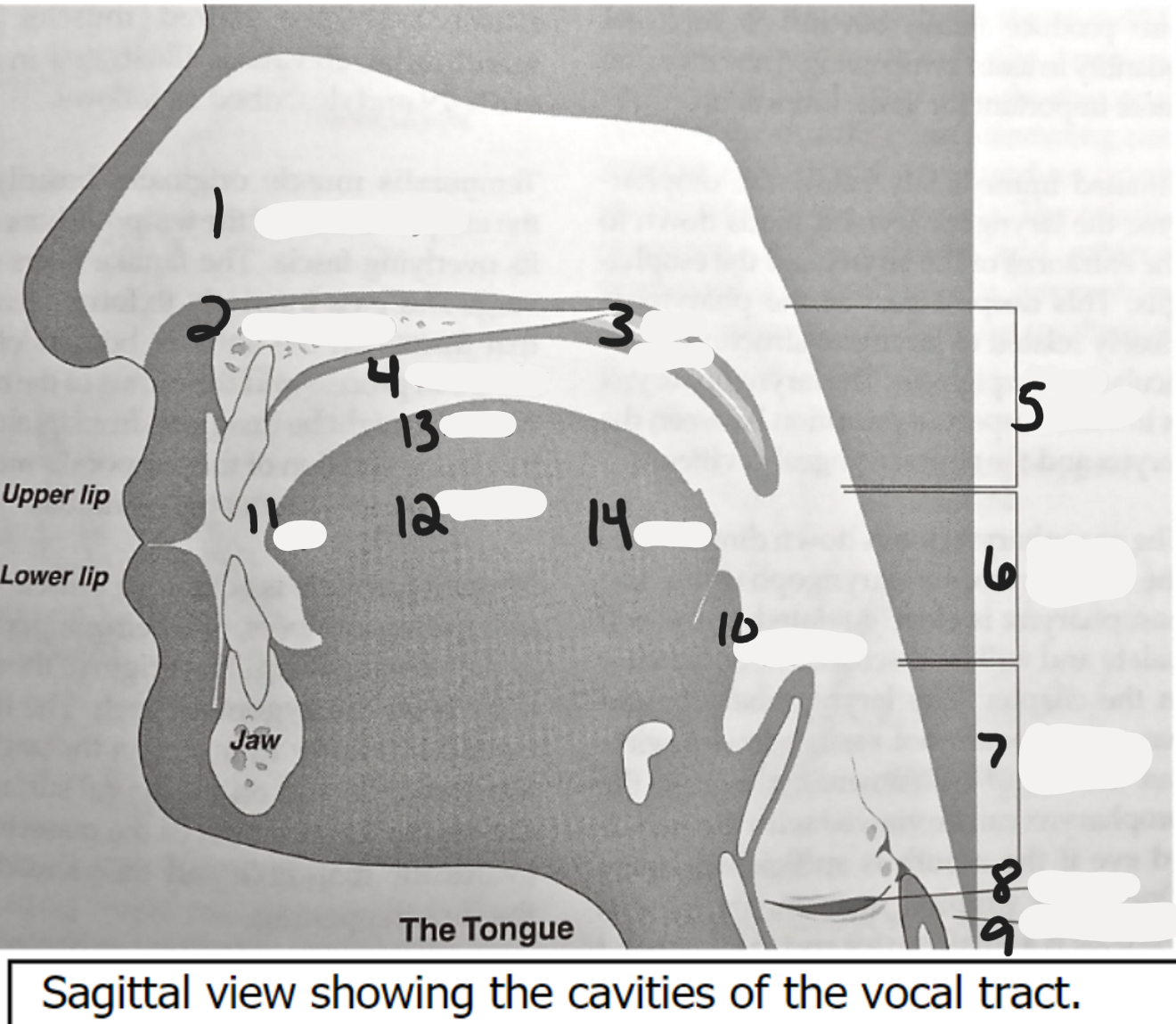
What is #2 on the diagram?
hard palate
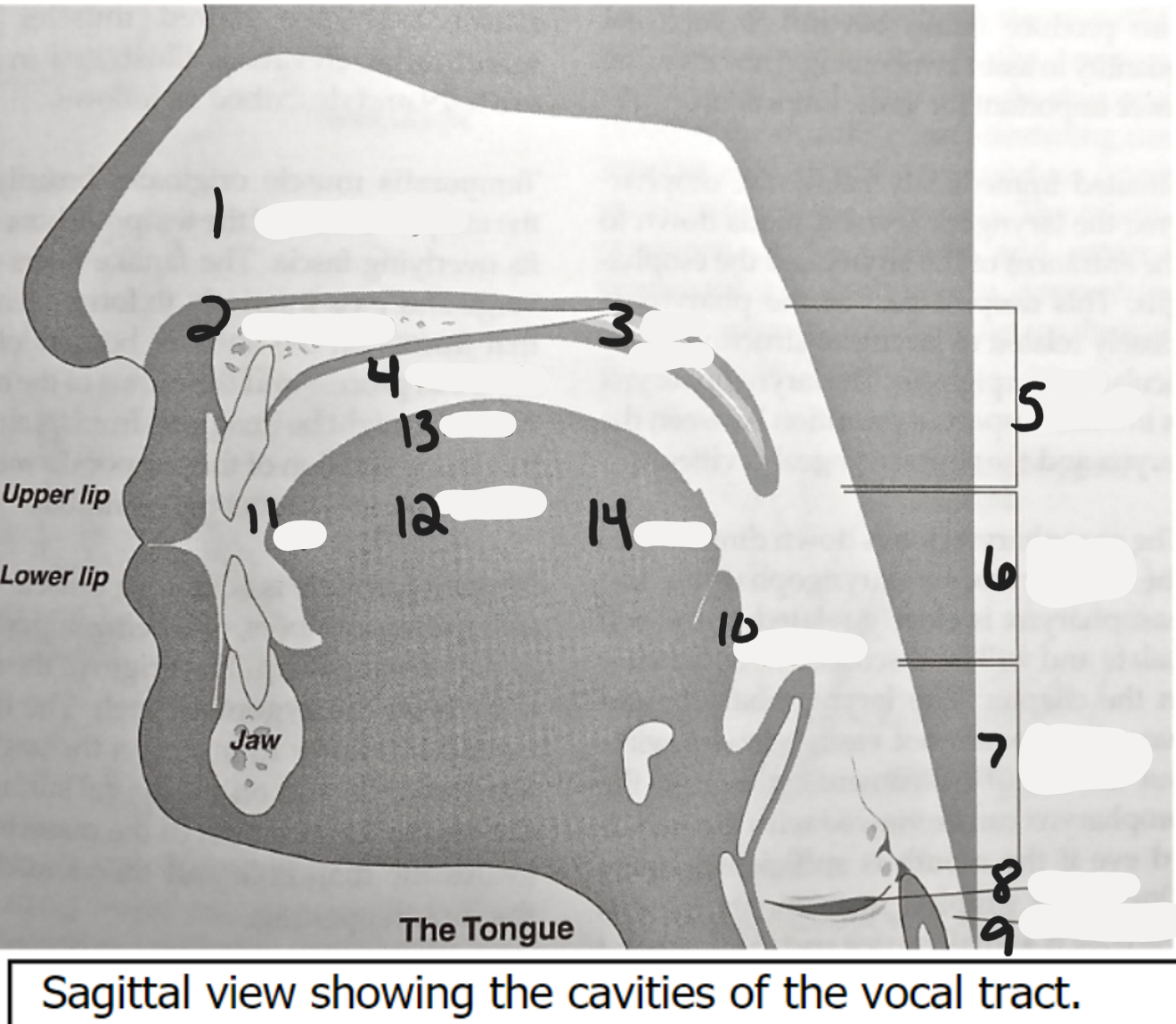
What is #3 on the diagram?
Soft palate
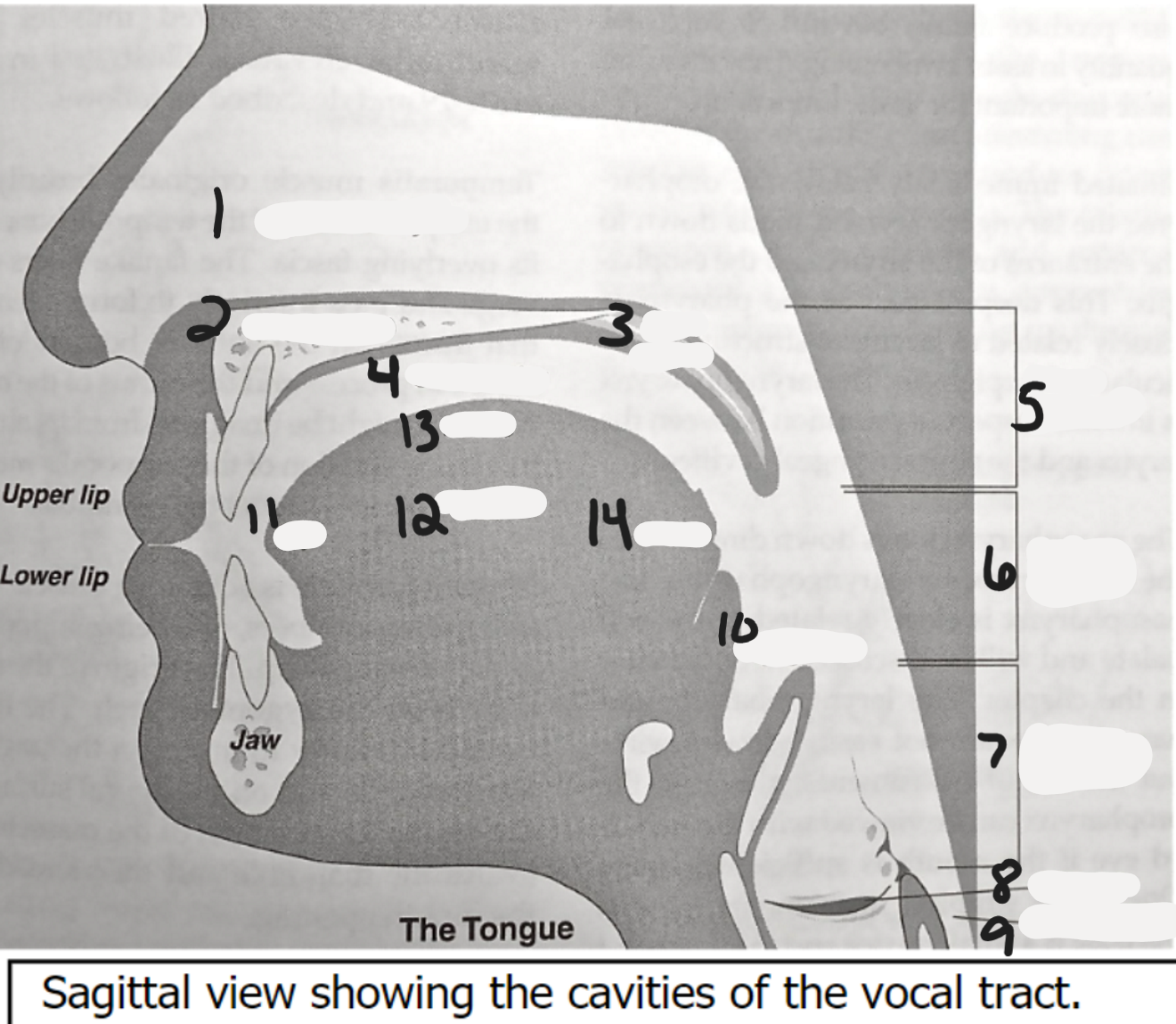
What is #4 on the diagram?
oral cavity
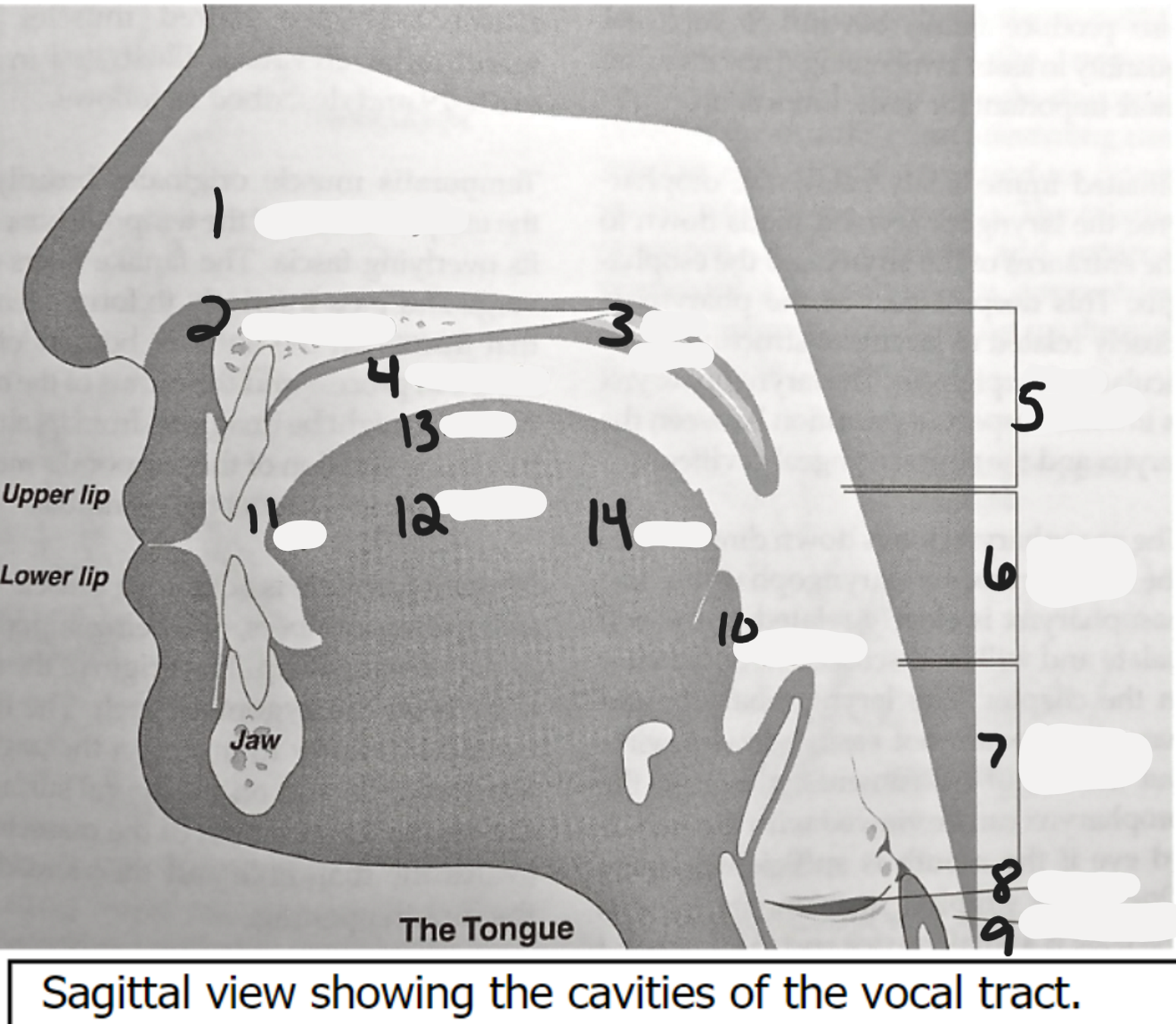
What is #5 on the diagram?
nasopharynx

What is #6 on the diagram?
oropharynx
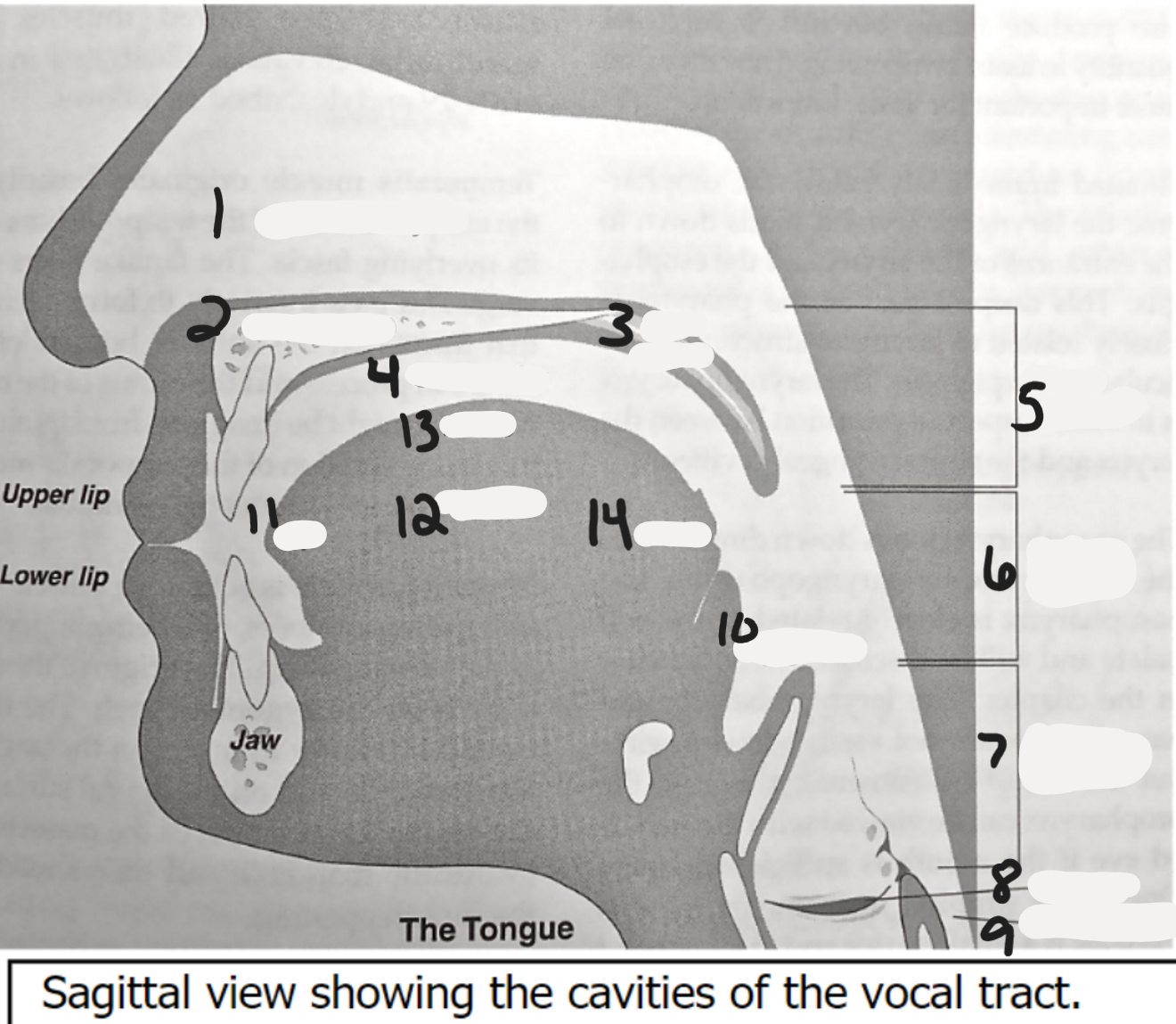
What is #7 on the diagram?
laryngopharynx
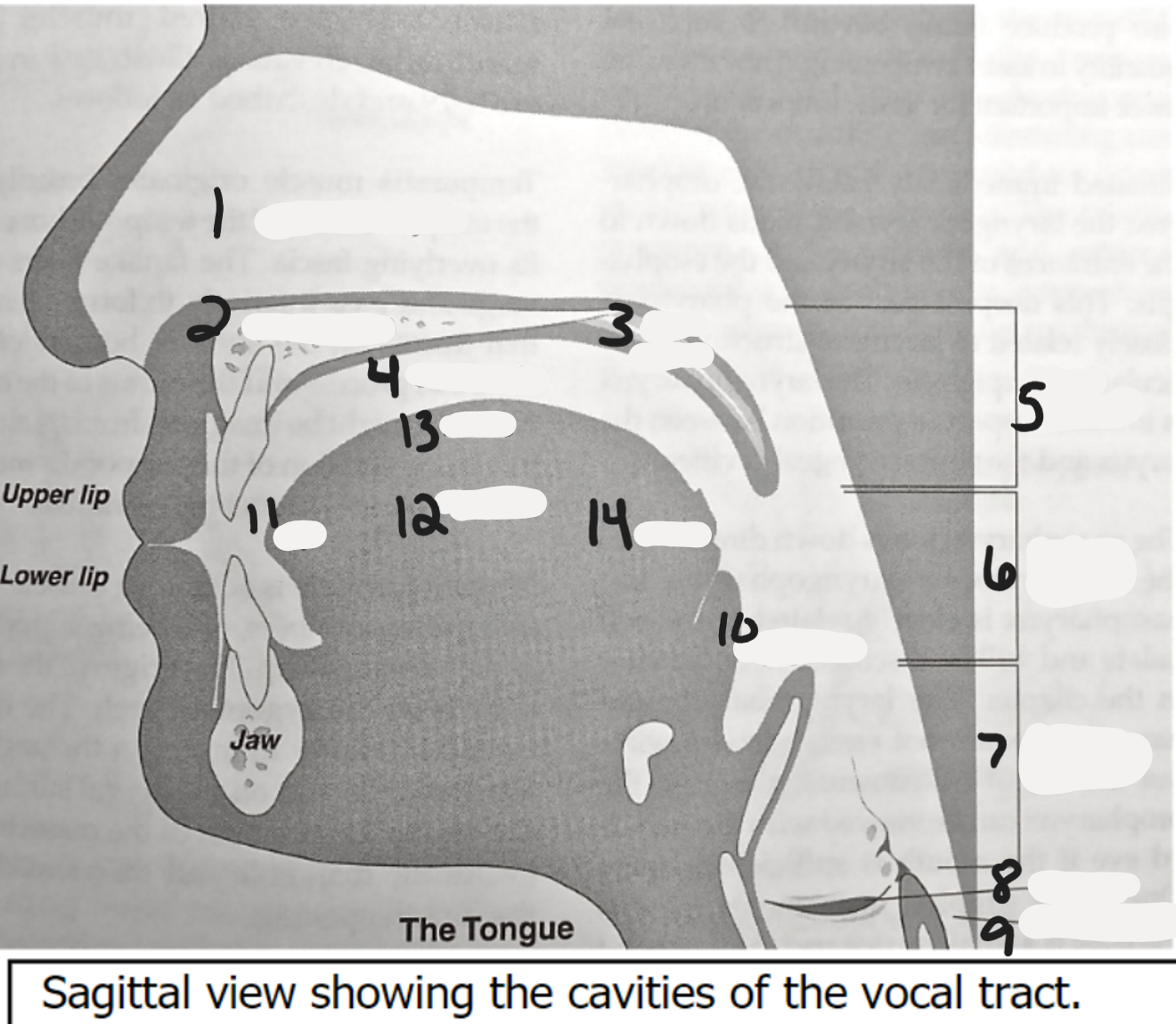
What is #8 on the diagram?
larynx
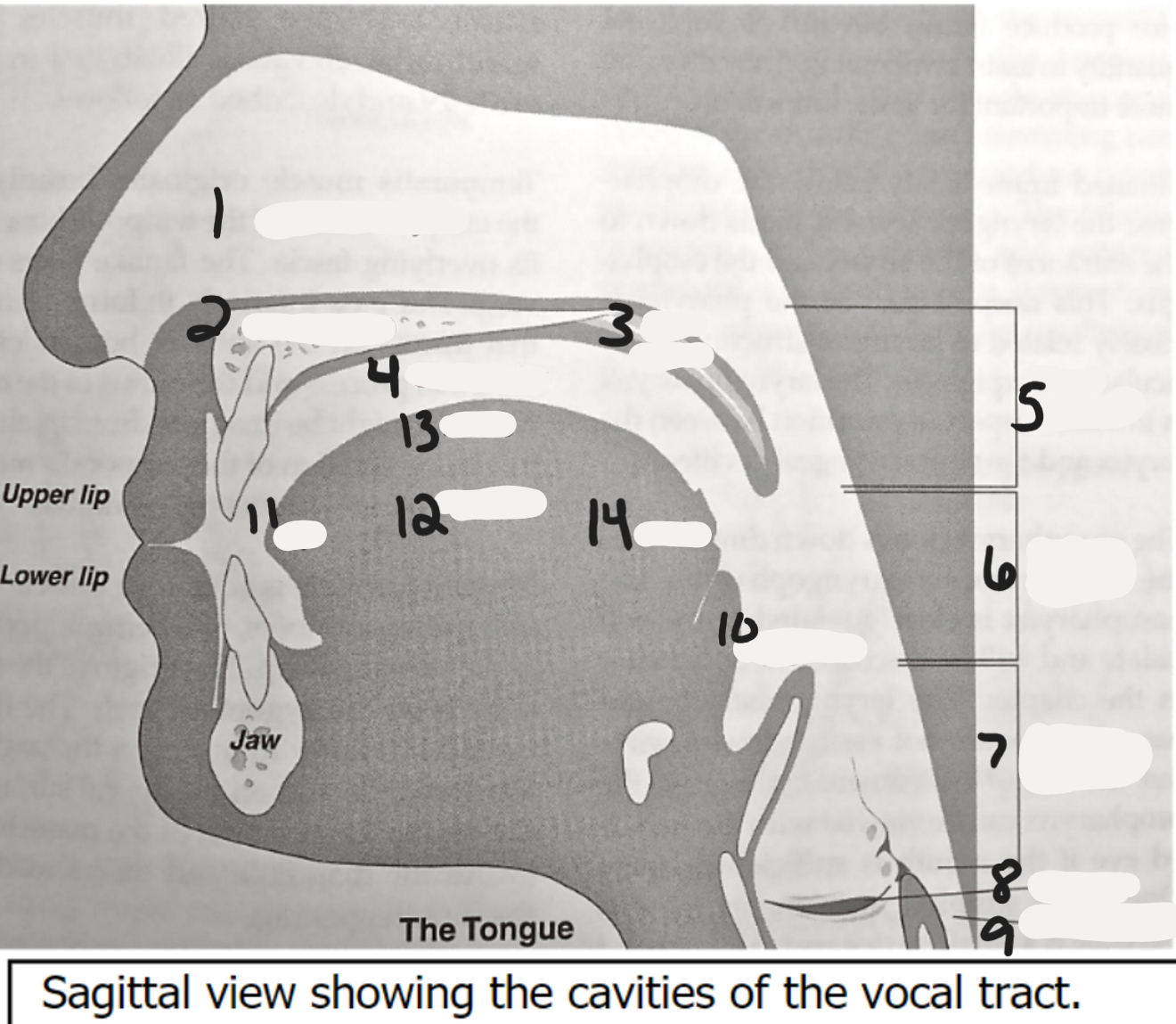
What is #9 on the diagram?
esophagus
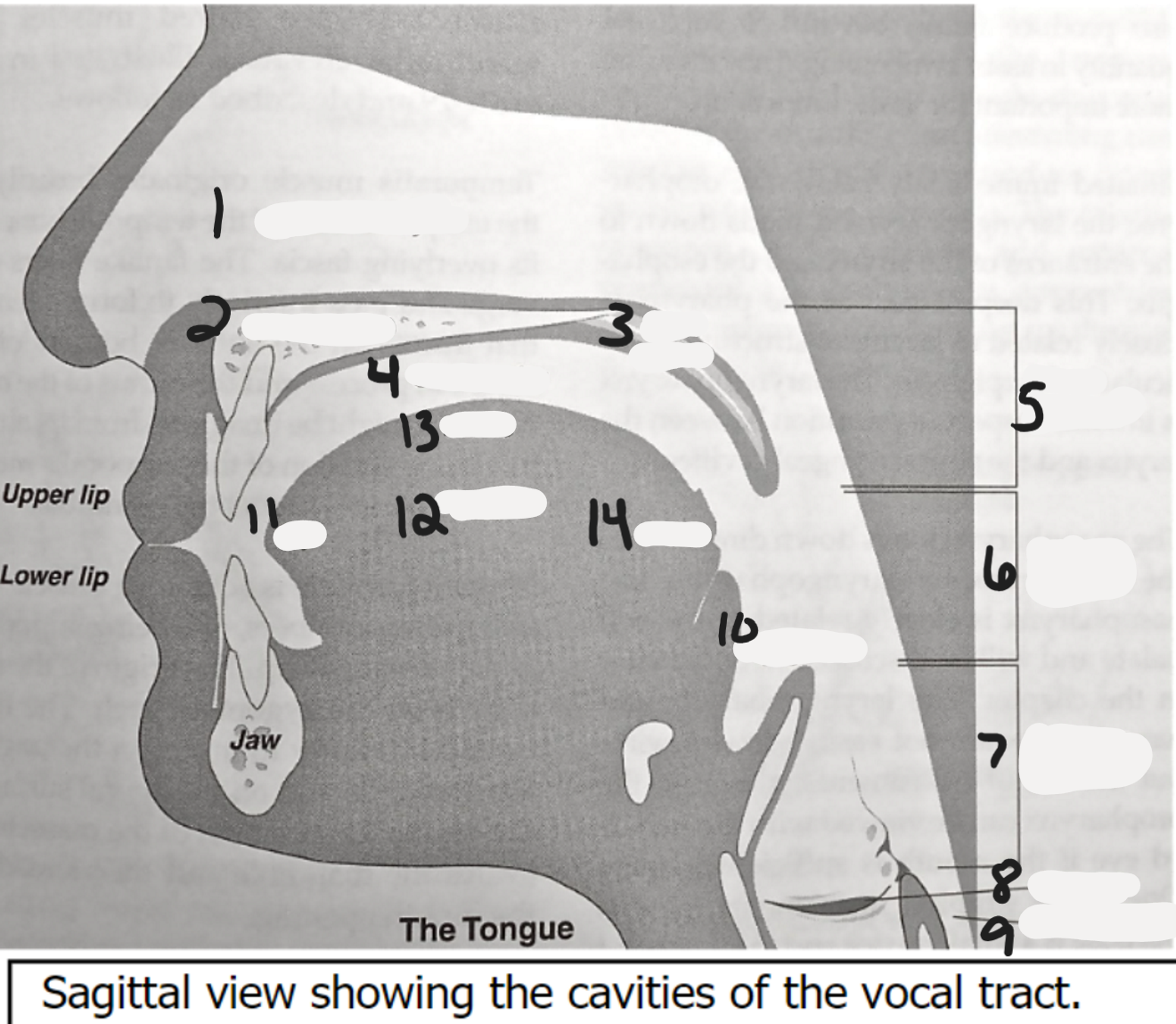
What is #10 on the diagram?
epiglottis

What is #11 on the diagram?
tongue tip
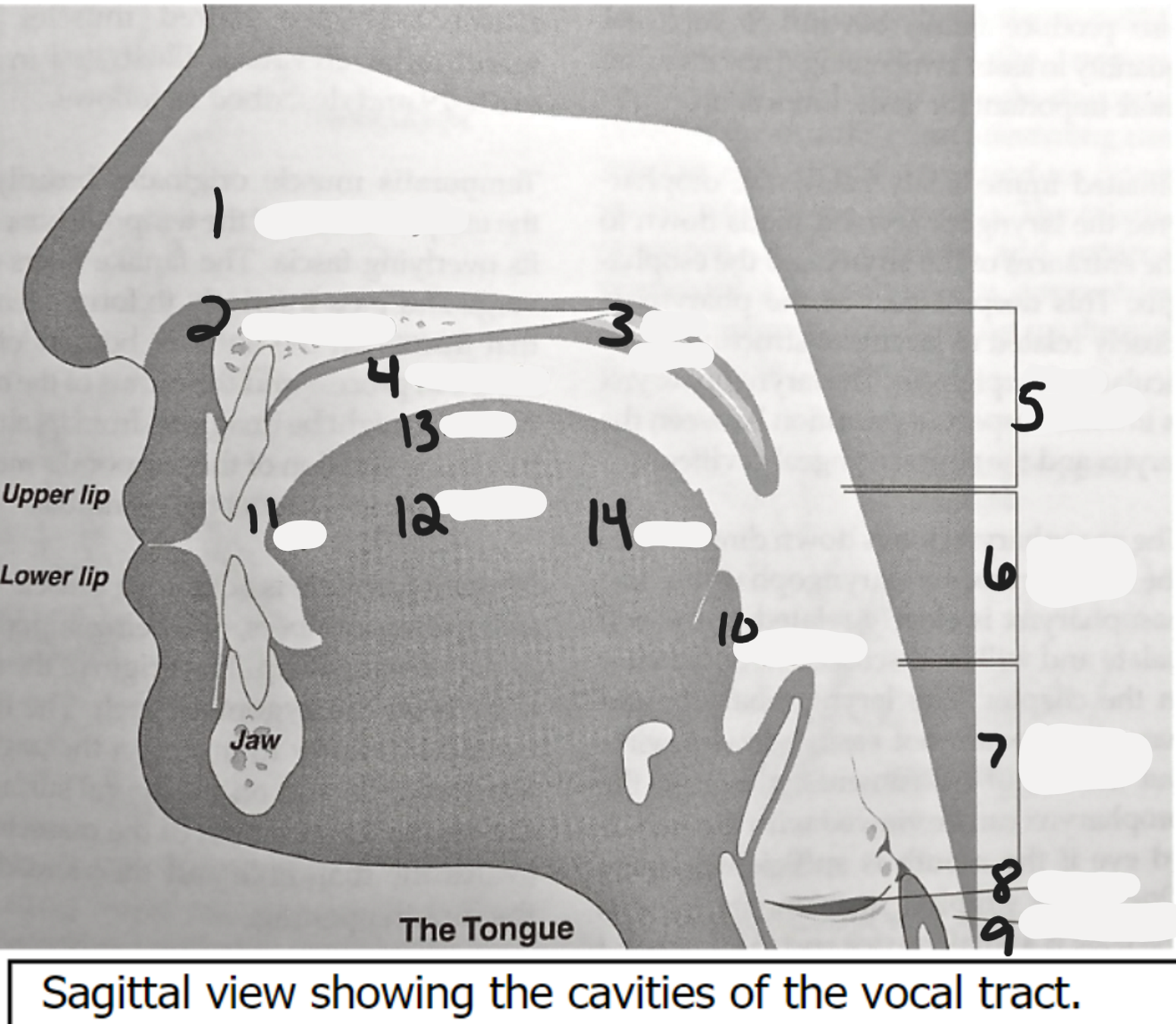
What is #12 on the diagram?
Tongue
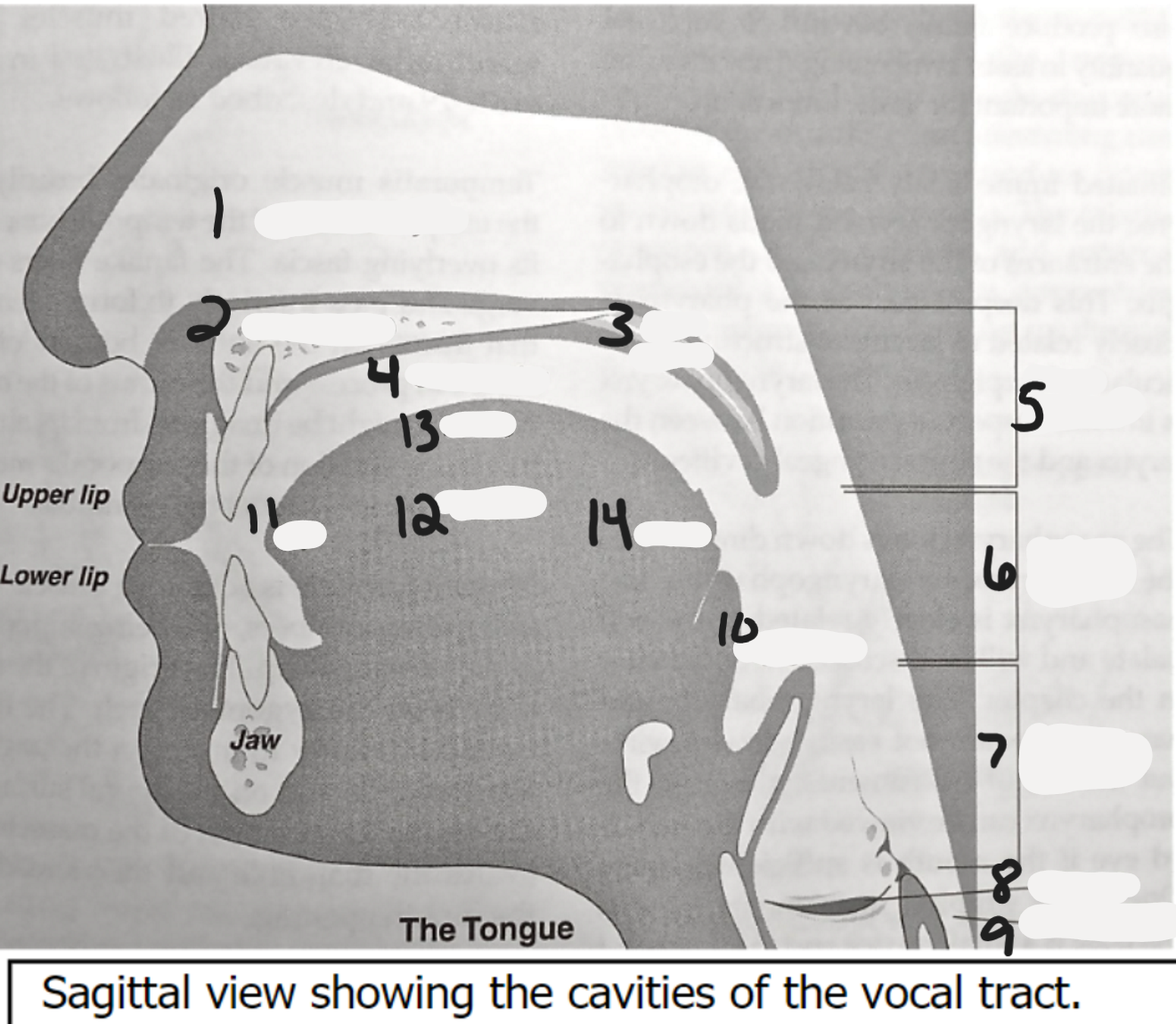
What is #13 on the diagram?
tongue blade

What is #14 on the diagram?
tongue root
What are the muscles of the face?
orbicularis oris
Buccinator
masseter
labii
Anguli oris
What three other muscles are included in the labii muscle?
Levator superioris
levator superioris alaque nasi
depressor inferioris
What two muscles fall under the anguli oris?
Levator
Depressor
What is the function of the Orbicularis Oris?
main muscle of the lips
one muscle, but can move separately between the upper and lower lip
What is the function of the Buccinator?
helps move food onto the molars
important for bolus formation
What is the function of the Masseter?
main purpose is to elevate the mandible
What is the function of the Labii Levator Superioris?
elevates upper lip
What is the function of the Labii Superioris Alaeque Nasi?
also elevates upper lip
What is the function of the Labii Depressor Inferioris?
pulls both lips down and out, opening them
What is the function of Anguli Oris?
works with corners of the mouth
What is the function of the Anguli Oris Levator?
draws corners of the mouth UP
What is the function of Anguli Oris Depressor?
draws corners of the mouth DOWN
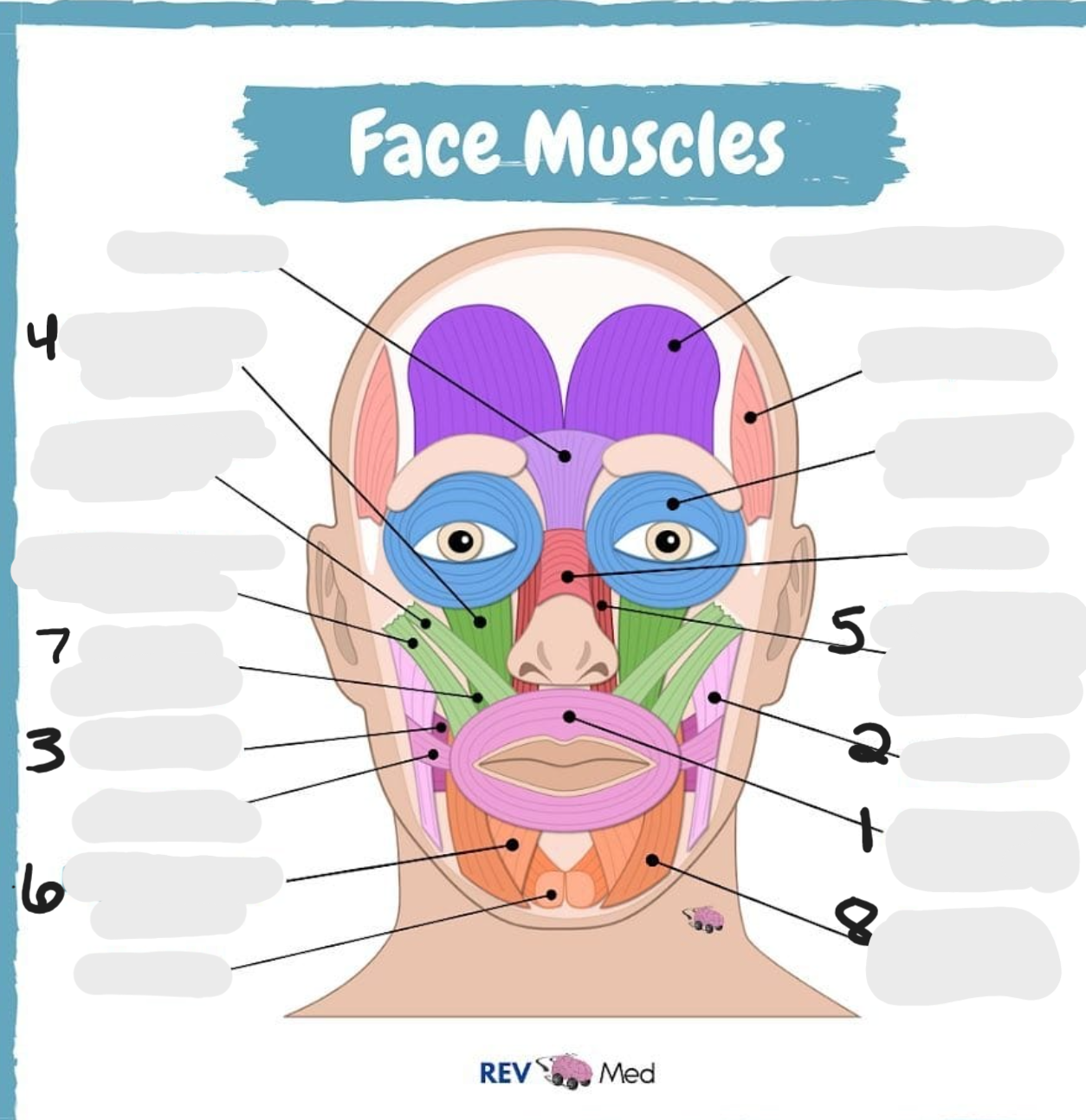
What is #1 on the diagram?
Orbicularis Oris
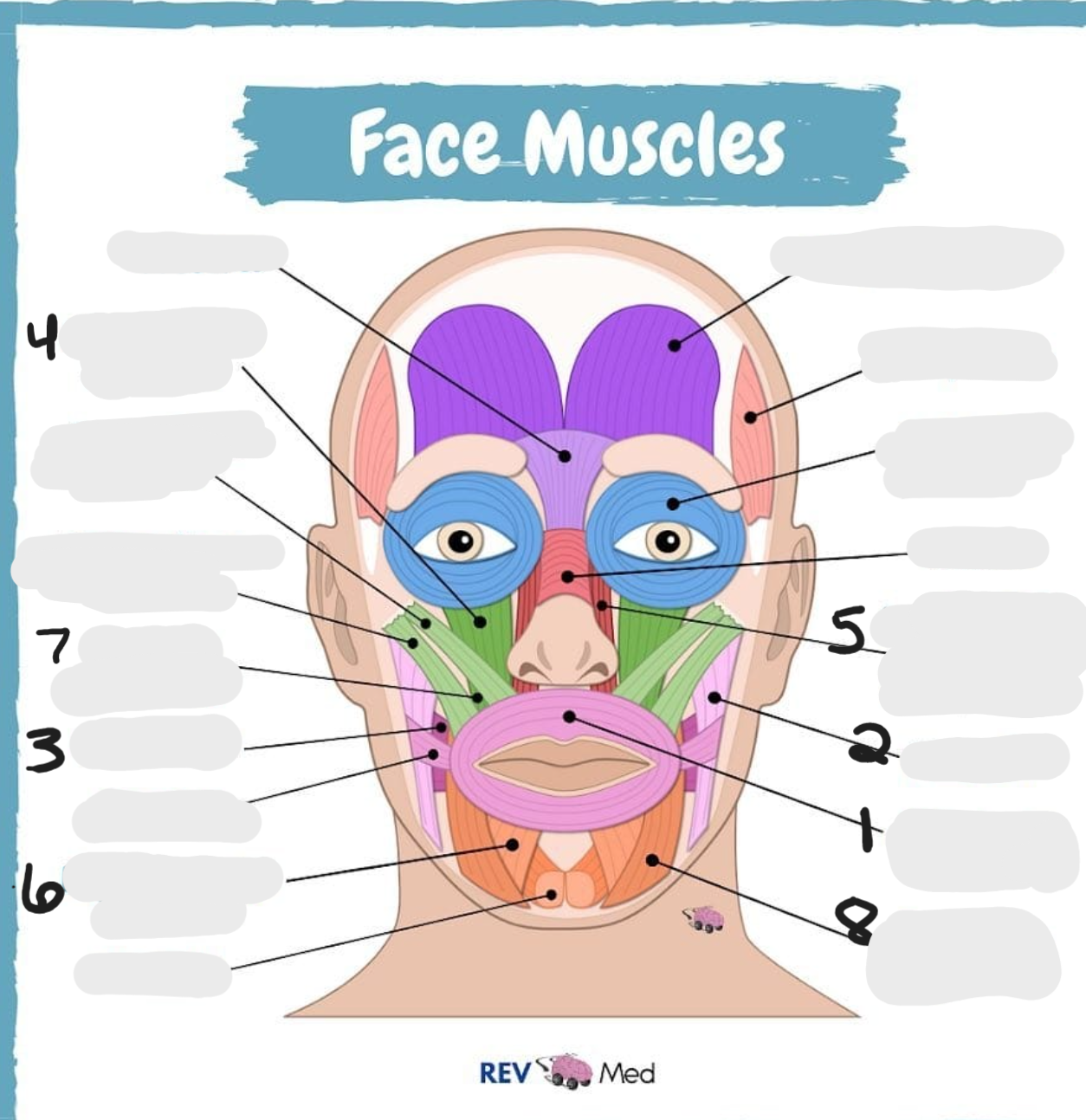
What is #2 on the diagram?
Massester

What is #3 on the diagram?
Buccinator

What is #4 on the diagram?
Levator Labii Superioris
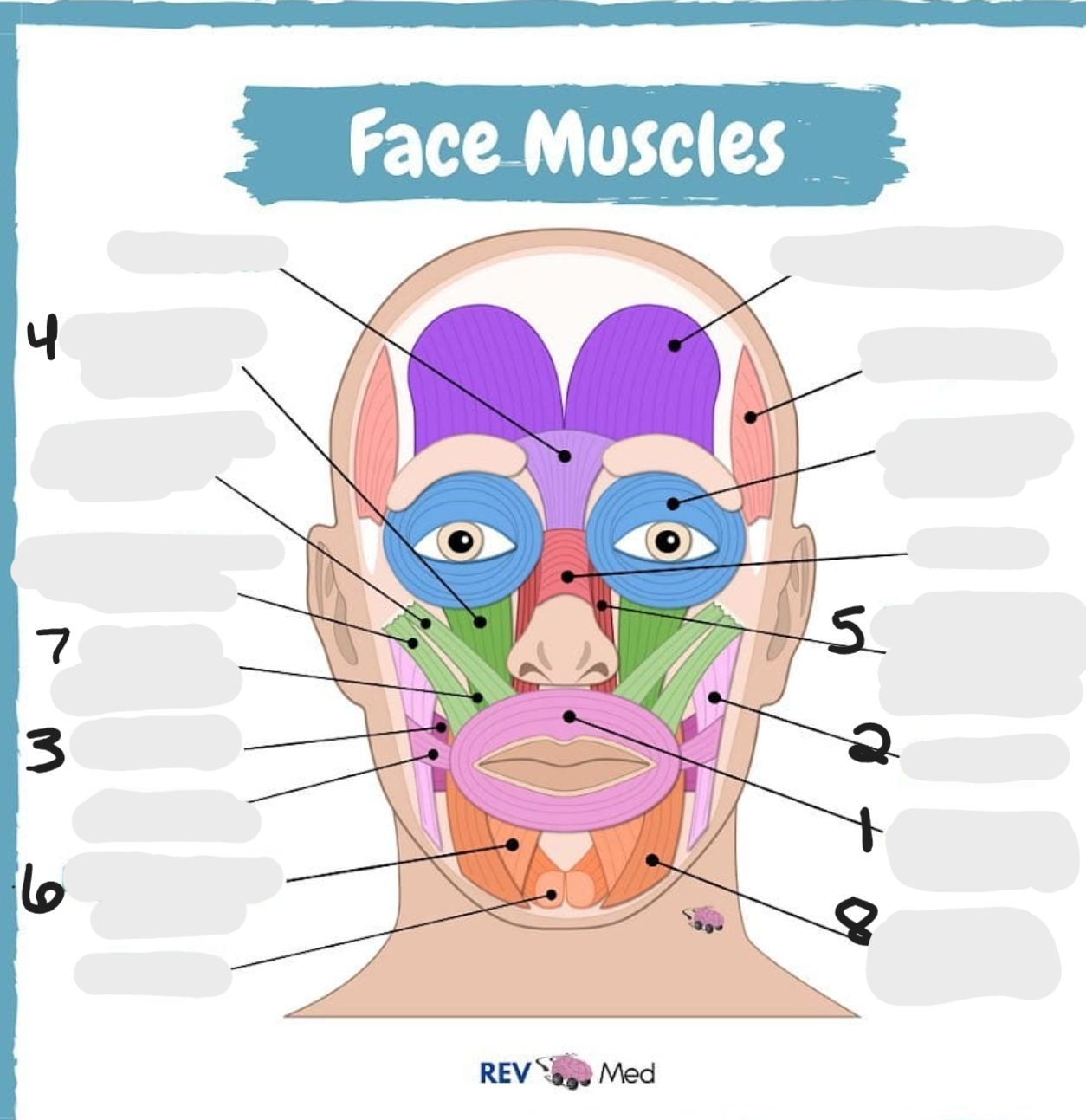
What is #5 on the diagram?
Levator Labii Superioris Alaeque Nasi
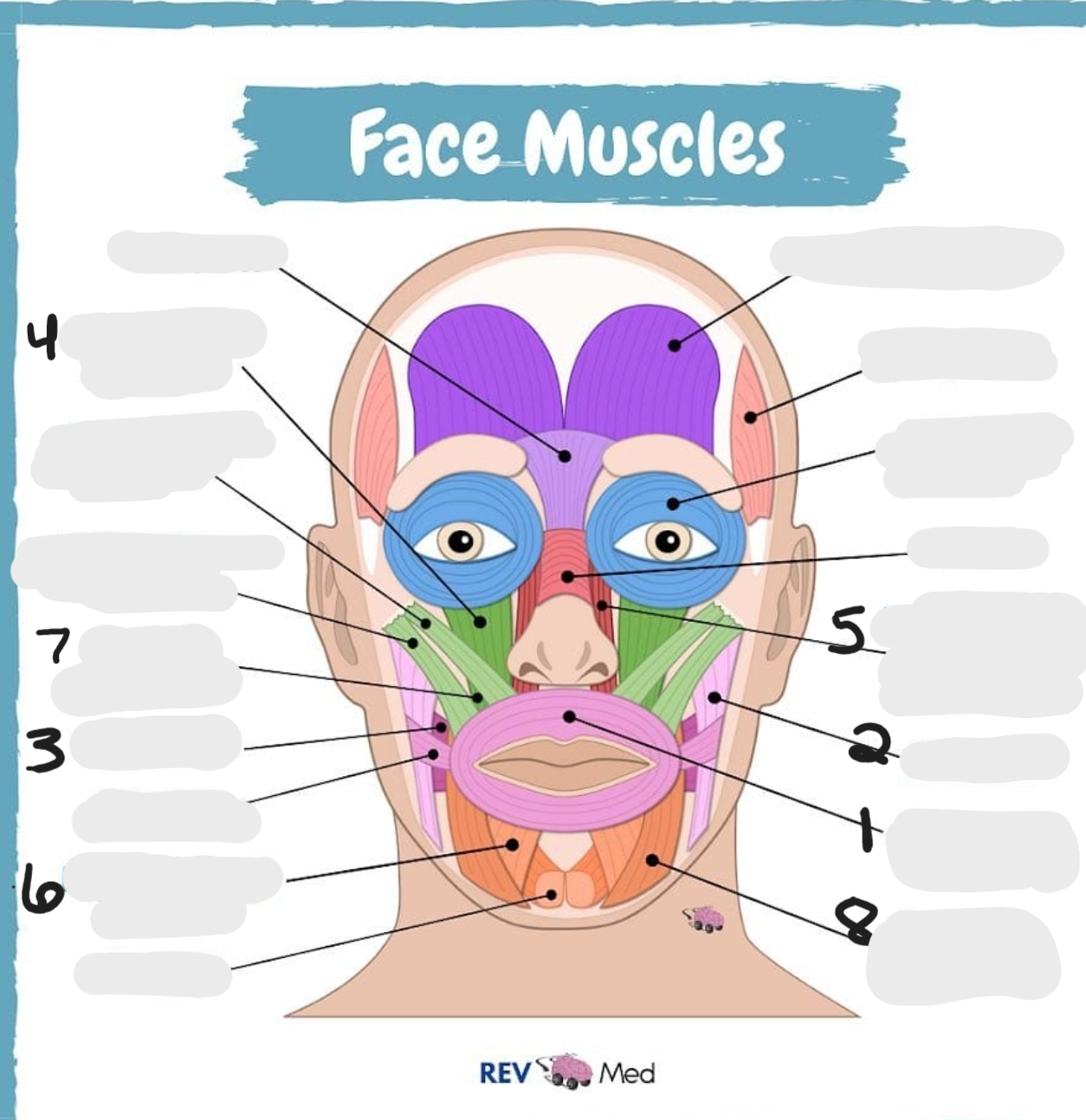
What is #6 on the diagram?
Depressor Labii Inferioris
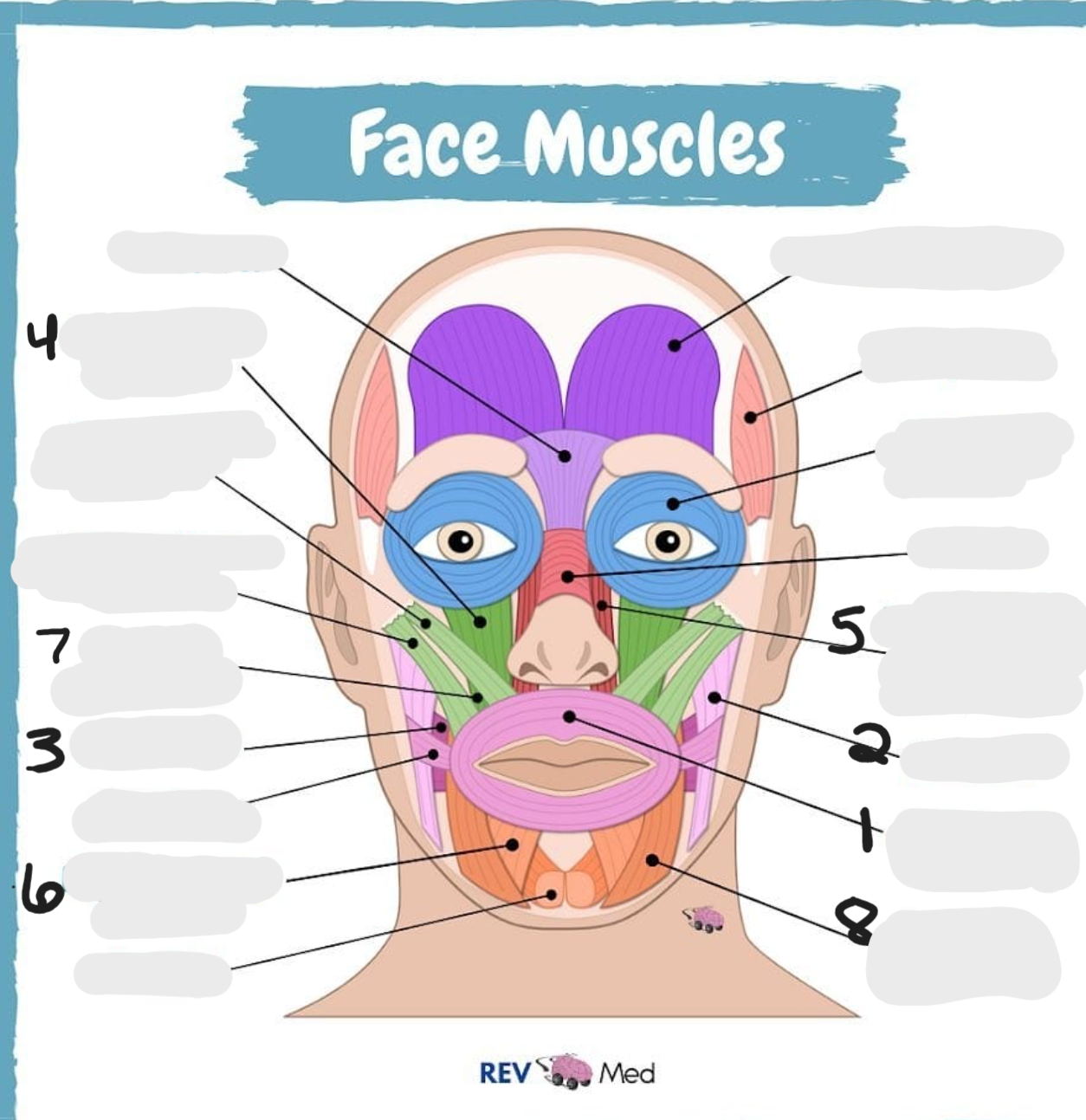
What is #7 on the diagram?
Levator Anguli Oris

What is #8 on the diagram?
Depressor Anguli Oris
Name the parts of the tongue
tongue root
tongue base
tongue blade/body
tongue tip
What is the function of the tongue root?
ROOT the tongue to the oral cavity
What is the function of the tongue base?
important in velar sounds (velar consonants- /k, g, ŋ/)
important in back vowels (/ʊ, u, o, ɔ, ɑ/)
helps propel bolus back into the pharynx
What is the function of the Tongue Body?
2/3 of the tongues total surface (including tip)
touches hard palate which helps us produce any sounds that use the tongue
What is the function of the Tongue Tip?
used for almost all alveolar sounds (/t, d, ɾ, s, z, n, l/)
tongue tie would form here

What is #1 on the diagram?
Tongue root
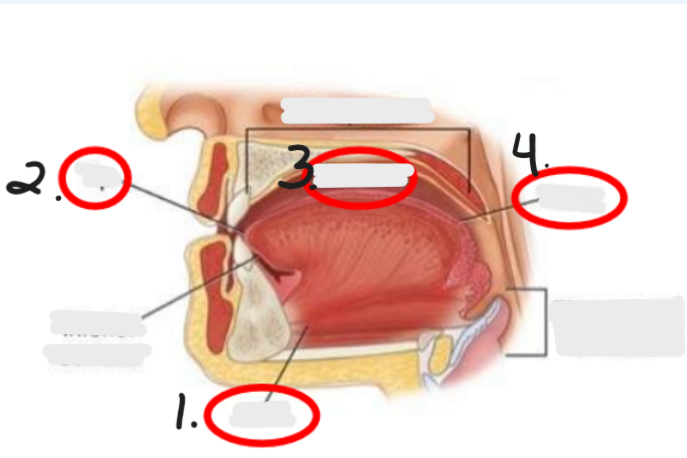
What is #2 on the diagram?
Tongue Tip
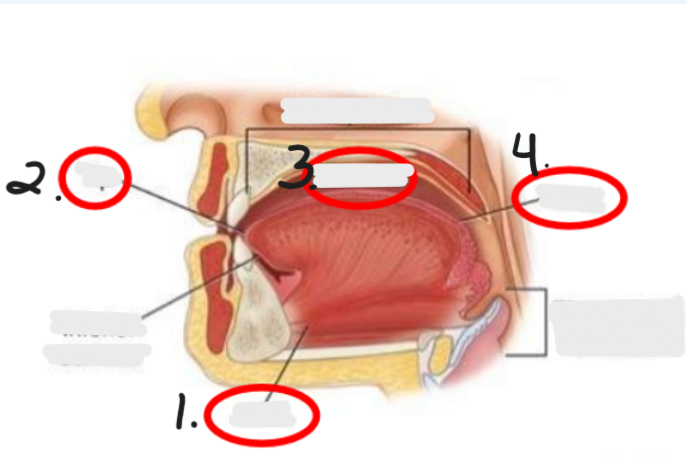
What is #3 on the diagram?
Tongue Blade/Body
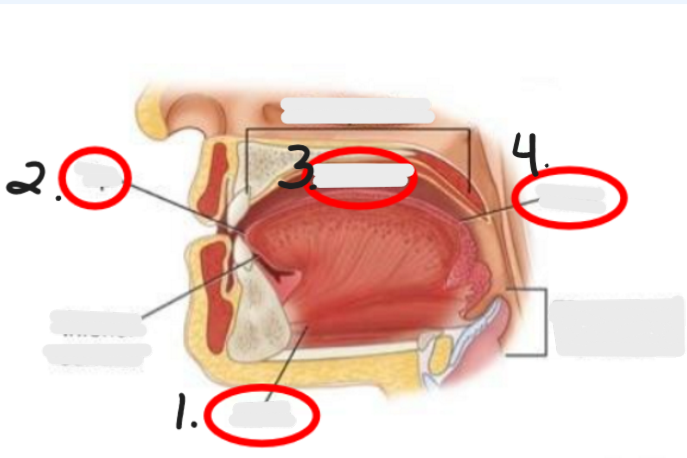
What is #4 on the diagram?
Tongue Base
What are the Intrinsic Muscles of the tongue?
Longitudinal muscles
Transverse muscles
Vertical Muscles
Describe the Longitudinal Muscles of the tongue
run length of tongue from BACK to FRONT
there are superior and inferior longitudinal muscles
Superior longitudinal muscles elevate the tongue tip
Inferior longitudinal muscles depress the tongue tip
Describe the Transverse muscles of the tongue
run LATERALLY (side to side) on the tongue
they NARROW the tongue; helps you do the hot dog roll
Describe the Vertical muscles of the tongue
run VERICALLY on the tongue (up & down)
they DEPRESS the tongue
help with vowels that use low tongue height
What are the Extrinsic Muscles of the tongue?
Genioglossus
Hyoglossus
Palatoglossus
Mylohyoid
Styloglossus
Describe the Genioglossus muscle
starts at the mandible, then inserts to tongue body
works to RETRACT the tongue (bring it in mouth)
PROTRUDES the tongue (stick tongue out)
further depresses the tongue
Describe the Hyoglossus muscle
starts at the hyoid bone, and runs to sides of the tongue
pulls sides of the tongue DOWN
Describe the Palatoglossus muscle
runs from palate down to the side of the posterior tongue (tongue base)
has two different functions
RAISES the tongue base
LOWERS the velum
Describe the Mylohyoid muscle
starts at mandible and inserts onto the hyoid bone
LOWERS and DEPRESSES the mandible
allows us to produce vowels like /ɑ/ and /o/
Describe the Styloglossus muscle
starts at styloid process and goes to the INFERIOR sides of the tongue at the body
when this muscle contracts it moves the tongue BACK and UP at the SAME time
allows us to produce velar sounds and high back vowels like /u/ and /ʌ/

What is #1 on the diagram?
Palatoglossus
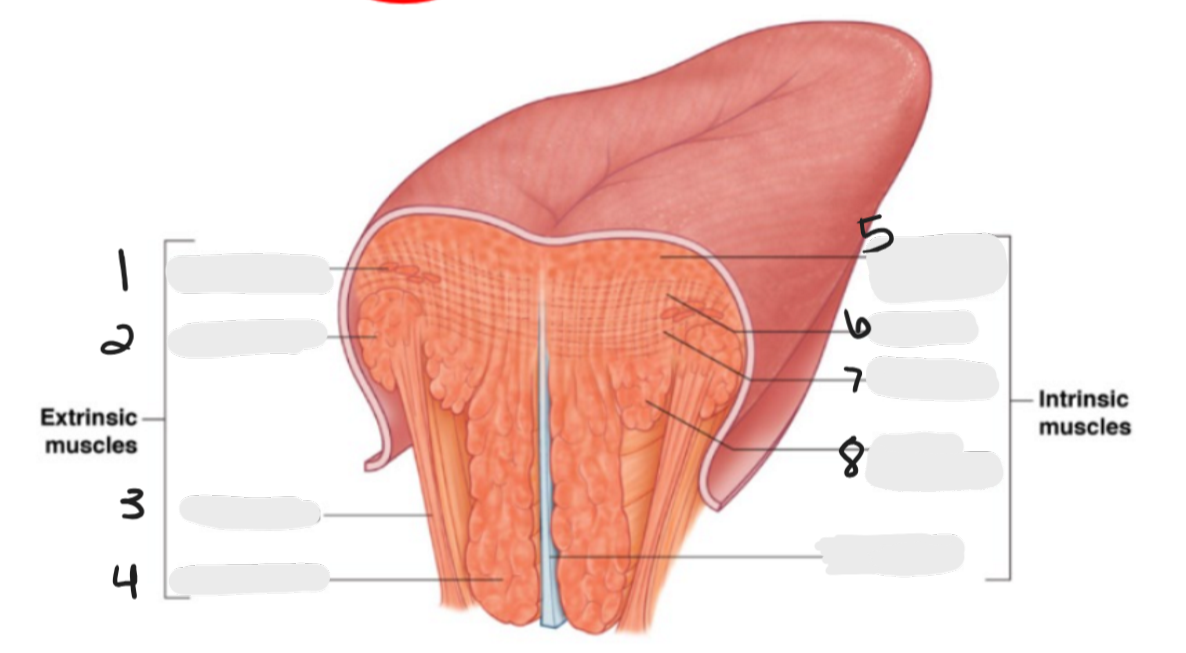
What is #2 on the diagram?
Styloglossus

What is #3 on the diagram?
Hyoglossus
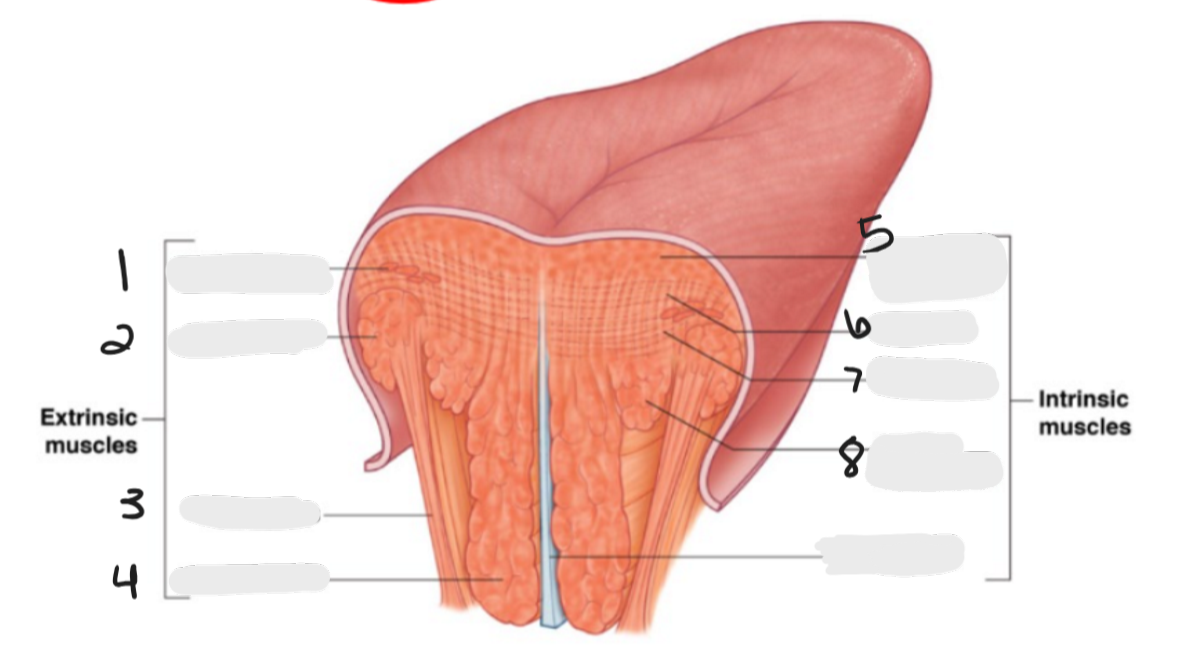
What is #4 on the diagram?
Genioglossus
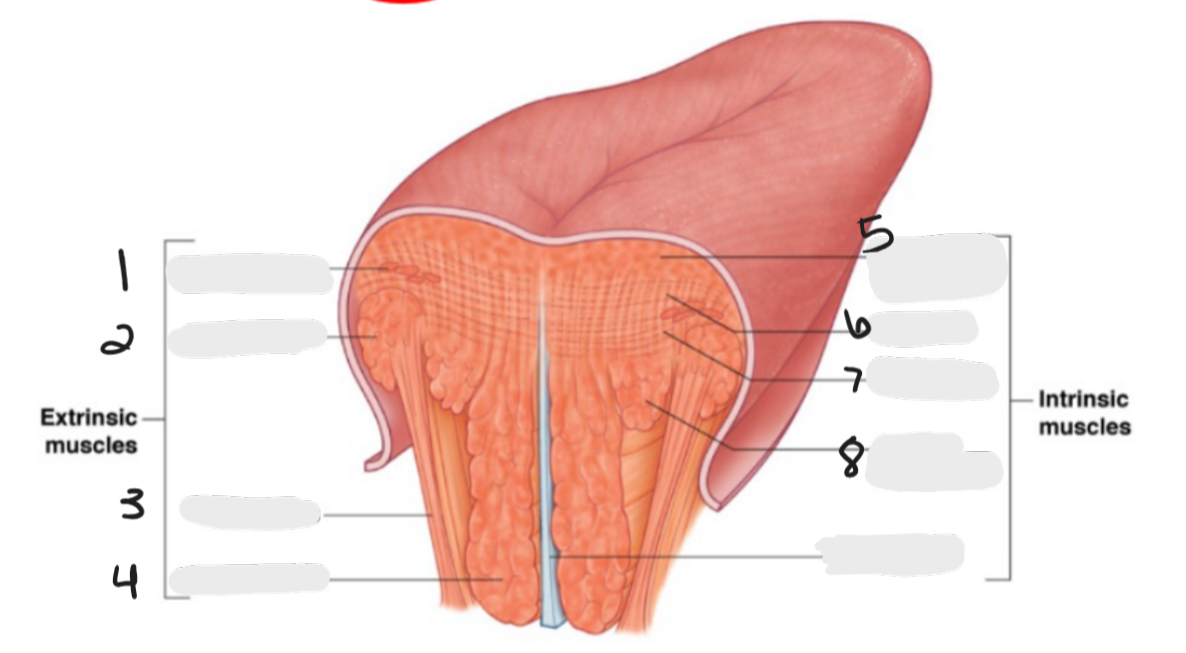
What is #5 on the diagram?
Superior Longitudinal Muscles
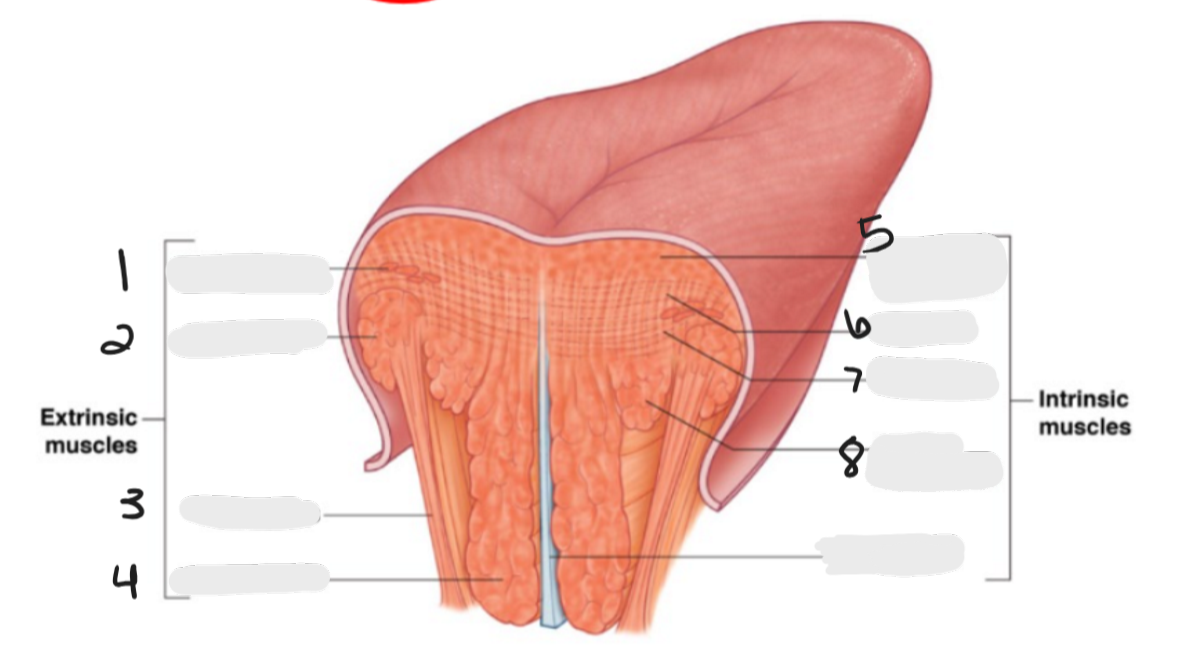
What is #6 on the diagram?
Vertical
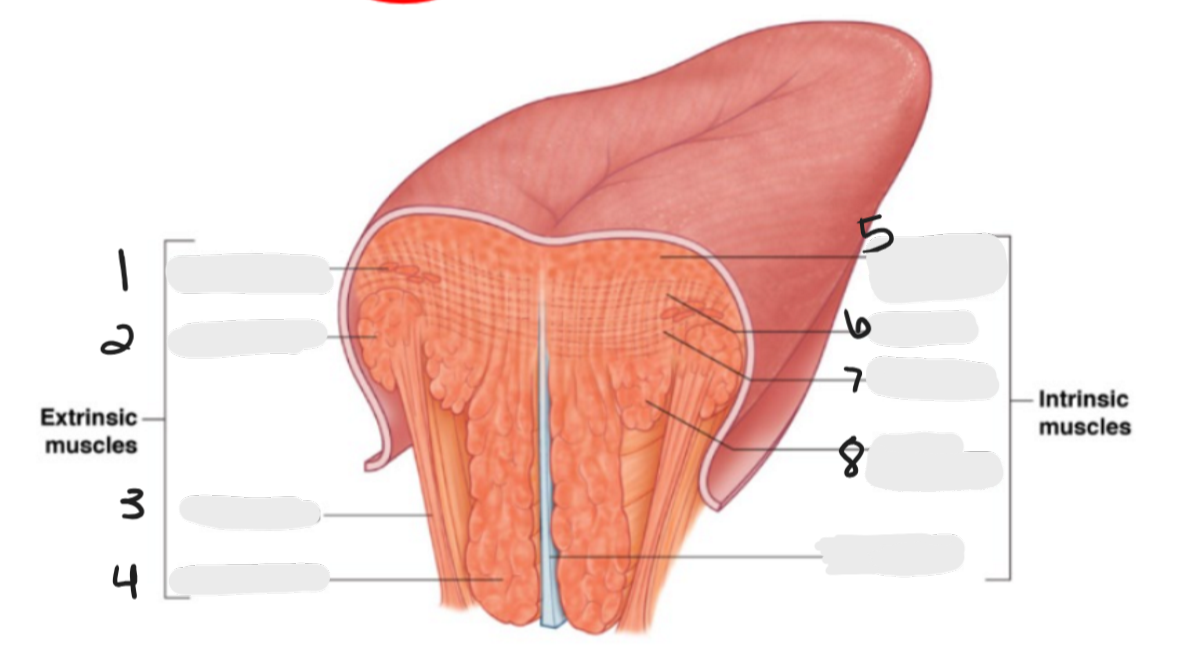
What is #7 on the diagram?
Transverse
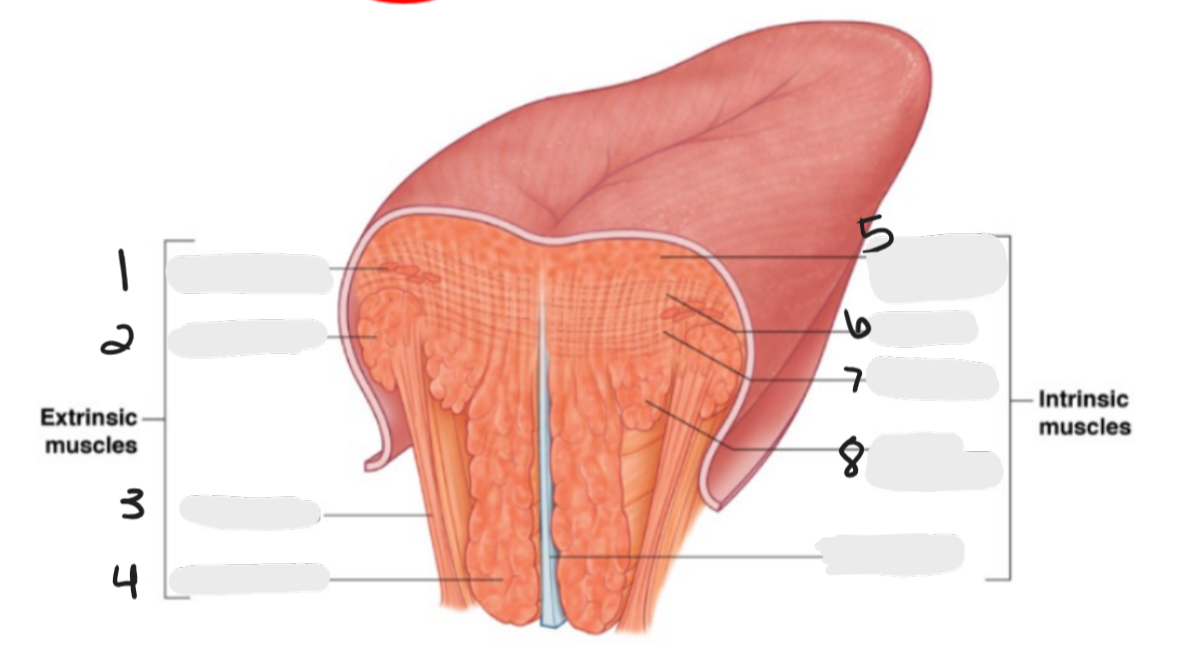
What is #8 on the diagram?
Inferior Longitudinal muscles
What muscle is used in tongue tip elevation?
superior longitudinal muscles
What muscle is used in tongue tip depression?
inferior longitudinal muscles
What muscle is used in tongue tip deviation?
ONE SIDE of the inferior longitudinal muscle
use this to sweep your mouth to clear food
What muscle is used in tongue protrusion?
genioglossus
What muscles is used in tongue retraction?
main one is genioglossus
styloglossus
What muscles are used in Tongue Base retraction?
styloglossus
hyoglossus
What muscle is used in tongue base elevation?
palatoglossus
moves tongue base UP ONLY
What are the muscles of the velum?
Levator veli palatini
Tensor veli palatini
Palatopharyngeus
Palatoglossus
What does the Levator Veli Palatini do?
ELEVATES and RETRACTS the velum
this helps close of the Velopharyngeal Port to produce oral consonants
What does the Tensor Veli Palatini do?
opens eustachian tubes
What does the Palatopharyngeus do?
DEPRESSES/LOWERS the velum and narrows the pharynx
helps us breath out of our nose and produce nasals)
What does the Palatoglossus do ?
ELEVATES the posterior tongue or lowers the velum along with the palatopharyngeal muscle
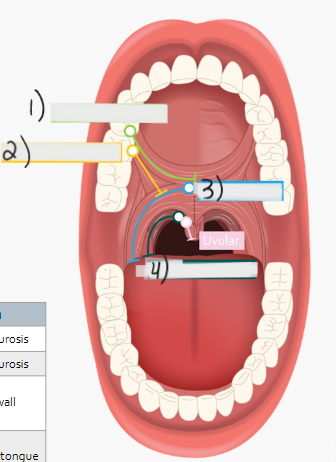
What is #1 on the diagram?
Tensor Levi Palatini
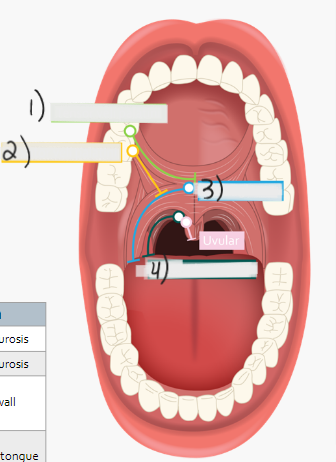
What is #2 on the diagram?
Levator Veli Palatini
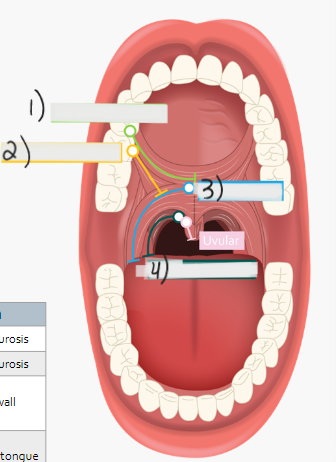
What is #3 on the diagram?
Palatoglossus
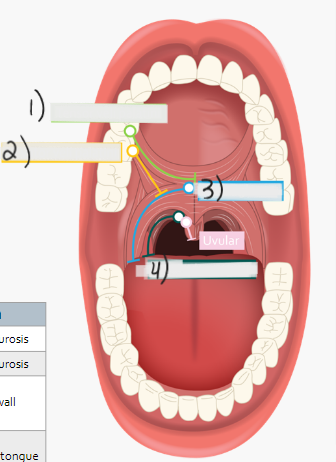
What is #4 on the diagram?
Palatopharyngeal
Tongue advancement is associated with what formant frequency?
Formant 2
Tongue height is associated with what formant frequency ?
Formant 1
As tongue height increases F1 __________.
decreases
The more fronted the tongue advancement, the ____________ the F2.
Higher